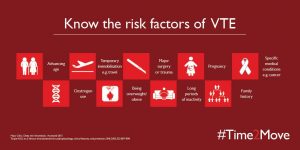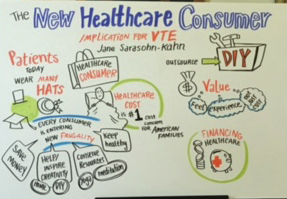 “Our goal is to create an aware and engaged, irritating set of patients who create a dialogue with health care providers once they’ve had a [blood] clot,” explained Randy Fenninger, CEO of the National Blood Clot Alliance (NBCA). NBCA’s tagline and hashtag is “Stop the Clot.”
“Our goal is to create an aware and engaged, irritating set of patients who create a dialogue with health care providers once they’ve had a [blood] clot,” explained Randy Fenninger, CEO of the National Blood Clot Alliance (NBCA). NBCA’s tagline and hashtag is “Stop the Clot.”
Welcome to the multi-stakeholder community involved with deep vein thrombosis (DVT) and, clinically speaking, Venous Thromboembolism (VTE). We’re talking blood clots, and the public health burden of this condition is big: it’s a leading cause of death and disability. One in 4 people in the world die of conditions caused by thrombosis.
I had the honor of chairing the 2nd Annual VTE Summit yesterday, held in the august Downton Abbey-esque Thomson Gallery in the College of Physicians of Philadelphia on 19 May 2016 (yesterday, in real time of writing this post).
 The meeting convened physicians, professional societies, nurses, patient advocates, researchers, health educators, marketers, communicators, all brainstorming the theme: “VTE: Making It Personal.” And personal this condition is: in the U.S. alone, there are about 900,000 VTEs that occur, resulting in 100,000 deaths. The risk pool grows every year because having one clot puts a person at risk of another clot. Combine that with rising risk for aging populations, and increased risk from smoking, obesity, hormonal imbalances, among other factors bolstering blood clots.
The meeting convened physicians, professional societies, nurses, patient advocates, researchers, health educators, marketers, communicators, all brainstorming the theme: “VTE: Making It Personal.” And personal this condition is: in the U.S. alone, there are about 900,000 VTEs that occur, resulting in 100,000 deaths. The risk pool grows every year because having one clot puts a person at risk of another clot. Combine that with rising risk for aging populations, and increased risk from smoking, obesity, hormonal imbalances, among other factors bolstering blood clots.
Putting patients at the center of preventing mortality from blood clots, and being more aware of them in recognizing their onset, is key to stemming the disease burden. There’s much people can do to engage with information, tools, and other patients, and many programs’ successes were shared during this conference. The use of social media has been especially useful in getting the word out about blood clots: my favorite moment of the day was mentioned by Dr. Elaine Hylek, Professor at the Boston University School of Medicine and Director of the Thrombosis and Anticoagulation Service at Boston Medical Center. She updated us on World Thrombosis Day, October 13, 2016, and a flash mob public display of “blood clots” who came together at the Brandenburg Gate in Berlin last year; here’s the video of the event.
This video has gone viral online, and has helped to grow awareness of the public health issue.
One of the many patient/consumer-focused participants at the meeting was the group Mended Hearts, among the largest patient social networks globally focused on heart health. The organization conducted a survey, results accessible here, quantifying the benefits of peer-to-peer support for patients’ health. [Hint: patient social networks can indeed bolster health in the community, and individual empowerment and engagement in healthcare].
Another outstanding patient-focused effort continues at the American College of Physicians, which has operated the Center for Patient Partnership in Healthcare since 2013. The team collaborates with physicians and patients to create content and tools that inspire, empower and engage patients to participate in their healthcare — supporting shared decision-making and self-care which drives better outcomes across conditions, including and being cardiovascular disease.
 Dr. Tom Ortel detailed the This is Serious program launched by Duke University School of Medicine, where Dr. Ortel is the Chief of the Division of Hematology in the Department of Medicine. Along with clinician-vetted health information, this site features personal stories on video to help promote DVT risk-awareness among women in various stages of life and circumstances.
Dr. Tom Ortel detailed the This is Serious program launched by Duke University School of Medicine, where Dr. Ortel is the Chief of the Division of Hematology in the Department of Medicine. Along with clinician-vetted health information, this site features personal stories on video to help promote DVT risk-awareness among women in various stages of life and circumstances.
 Health Populi’s Hot Points: “The patient is the only continuity,” one of our breakout session participants said at the end of the day. This goes for self-care after discharge from hospital into the community, and the lack of communication, data gaps, and continuity of care that can exacerbate the DVT survivor’s risk of blood clots that could kill them the second (or third) time around.
Health Populi’s Hot Points: “The patient is the only continuity,” one of our breakout session participants said at the end of the day. This goes for self-care after discharge from hospital into the community, and the lack of communication, data gaps, and continuity of care that can exacerbate the DVT survivor’s risk of blood clots that could kill them the second (or third) time around.
The comment that the patient is the only continuity strongly resonated with me, full circle, by late afternoon, as I kicked off the morning session talking about the new healthcare consumer. The graphically recorded results of my talk appear in the picture, artfully captured by Yao Xiao of IMAGETHINK (no relation to THINK-Health, my firm!).
The role of the patient-consumer in health and healthcare cannot be overstated in this emerging area of value-based care, and rising costs. Patients bear increasing financial health-risk, with $1 in every $5 of household spending being allocated to healthcare for every American family, making healthcare costs the #1 pocketbook issue for people across all income strata. One DVT patient explained to me that a particular test for blood clots can cost a patient between $5,000 and $10,000 — that single line item getting a patient-health plan member to their deductible. It’s also a sticker-shock cost that dissuades some patients, according to my expert DVT patient, to forgo the test (which we at THINK-Health consider “self-rationing due to cost“).
Putting patients at the center of healthcare and making healthcare personal and personalized should be the M.O. for all health stakeholders in the healthcare ecosystem. The patient is indeed the only continuity in the fragmented, labyrinthine U.S. health care system.





 Interviewed live on BNN Bloomberg (Canada) on the market for GLP-1 drugs for weight loss and their impact on both the health care system and consumer goods and services -- notably, food, nutrition, retail health, gyms, and other sectors.
Interviewed live on BNN Bloomberg (Canada) on the market for GLP-1 drugs for weight loss and their impact on both the health care system and consumer goods and services -- notably, food, nutrition, retail health, gyms, and other sectors. Thank you, Feedspot, for
Thank you, Feedspot, for  As you may know, I have been splitting work- and living-time between the U.S. and the E.U., most recently living in and working from Brussels. In the month of September 2024, I'll be splitting time between London and other parts of the U.K., and Italy where I'll be working with clients on consumer health, self-care and home care focused on food-as-medicine, digital health, business and scenario planning for the future...
As you may know, I have been splitting work- and living-time between the U.S. and the E.U., most recently living in and working from Brussels. In the month of September 2024, I'll be splitting time between London and other parts of the U.K., and Italy where I'll be working with clients on consumer health, self-care and home care focused on food-as-medicine, digital health, business and scenario planning for the future...